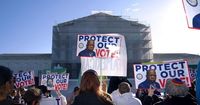On Wednesday, October 15, 2025, the U.S. Supreme Court took center stage in a high-stakes battle over the future of voting rights and political representation in America. At issue: Louisiana’s congressional map, the Voting Rights Act’s core protections against racial discrimination, and—potentially—the balance of power in Congress for years to come.
It’s a case that’s been years in the making, tangled in legal arguments and political maneuvering. According to the Associated Press, the justices are hearing arguments for the second time regarding Louisiana’s congressional map, which currently features two majority Black districts. This is a marked shift from the state’s previous arrangement, which included just one such district—a setup that drew a lawsuit claiming it diluted the voting power of Black residents.
But when state lawmakers responded by redrawing the map to create a second majority Black district, a new lawsuit emerged. This time, non-Black voters in the newly drawn district argued that the new map amounted to unconstitutional racial gerrymandering. As reported by Forbes, these plaintiffs claimed legislators had “sacrificed traditional redistricting factors” to create a district based solely on race.
Now, the Supreme Court is weighing not just which map should stand, but whether the very act of demanding a second majority-Black district violates the Equal Protection Clause of the Fourteenth Amendment and the Fifteenth Amendment, which guarantees citizens the right to vote regardless of race or color. The case has ballooned in significance, with justices signaling their intent to address the legality of Section 2 of the Voting Rights Act—a provision that has long served as a bulwark against racially discriminatory voting practices.
The stakes could hardly be higher. Should the court weaken or strike down Section 2, Republican-controlled states across the South and beyond would gain far greater leeway to redraw congressional districts in ways that could dilute the votes of minority populations—who, statistically, are more likely to support Democratic candidates. According to a study cited by Forbes and conducted by Fair Fight Action and Black Voters Matter Fund, overturning Section 2 could allow Republicans to create up to 27 more safe GOP seats in the House of Representatives, with 19 of those potentially flipping as a direct result of the decision—even before the next census in 2030.
It’s not the first time the Supreme Court has found itself at the heart of a redistricting storm. Just two years ago, the court affirmed a lower-court ruling that found a likely Voting Rights Act violation in Alabama’s congressional map. That 5-4 decision, with Chief Justice John Roberts and Justice Brett Kavanaugh joining the court’s three liberal justices, led to new districts in Alabama and Louisiana that sent two more Black Democrats to Congress.
But the court’s conservative majority has shown a deep skepticism toward race-conscious policies of late. Most recently, they ended affirmative action in college admissions. And as the Associated Press notes, twelve years ago the court took a “sledgehammer” to another pillar of the Voting Rights Act, striking down the requirement that states with a history of racial discrimination get federal approval before making changes to election laws.
The legal saga over Louisiana’s map has been particularly convoluted. After the 2020 census, the state’s Republican-dominated legislature drew a new congressional map in 2022 that effectively maintained the status quo: five Republican-leaning, majority-white districts and one Democratic-leaning, majority-Black district. Civil rights advocates challenged the map, winning a lower-court ruling that found it likely discriminated against Black voters. In response, the state drew a new map with two majority-Black districts, but this, too, was challenged—this time by white voters who argued that race was the predominant factor in the redistricting process.
Chief Justice Roberts, during the first round of arguments in March, expressed skepticism about the second majority Black district, describing it as a “snake” that stretches more than 200 miles to link disparate parts of Shreveport, Alexandria, Lafayette, and Baton Rouge. It’s a vivid image, and one that underscores the complexity—and, critics say, the contortion—of efforts to balance racial representation with traditional redistricting principles.
The court’s decision, expected before the end of its term in June 2026, could have immediate and sweeping consequences. If the justices side with Louisiana’s white voters and weaken Section 2, legislatures across the South would have a green light to redraw maps, potentially eliminating majority Black and Latino districts that have historically favored Democrats. As Forbes reports, this could “essentially ensure Republicans will control the House for years.”
The timing of the ruling is crucial. It will likely determine whether the new map with a second majority-Black district will be used in the 2026 midterms or if the present map remains in place until 2028. The Associated Press notes that this mid-decade redistricting battle is already playing out nationwide, with Republican-led states like Texas, Missouri, Indiana, and North Carolina moving to redraw districts ahead of 2026, disrupting the traditional ten-year redistricting cycle. Democratic-led states such as California and Maryland have responded in kind, seeking to bolster their own party’s representation.
Louisiana’s demographics underscore the importance of the case: about 33% of its residents are Black, and Black voters comprise 31% of the state’s voting-age population, according to court filings cited by Forbes. The outcome could set a precedent for how minority voting power is protected—or not—across the country.
Historically, the Supreme Court has played a pivotal role in shaping the Voting Rights Act’s reach. In 2013’s Shelby County v. Holder, the court struck down a key section of the law, making it easier for states to impose restrictive voting laws. Subsequent decisions, such as Abbott v. Perez in 2018 and Brnovich v. Democratic National Committee in 2021, have further limited the law’s scope. Yet, as recently as 2023, the court voted to preserve the VRA’s protections against diluting Black votes in Alabama—a reminder that the court’s stance on voting rights can still surprise observers.
The Louisiana case has already had tangible political consequences. In the 2024 election, the new second majority-Black district was used, and Democratic Rep. Cleo Fields emerged victorious, unseating Republican incumbent Garret Graves. The Supreme Court allowed the map to be used despite ongoing legal challenges, later punting the case for a second round of arguments this term.
As the justices deliberate, the nation watches closely. The outcome will not only shape Louisiana’s representation in Congress but could fundamentally alter the rules of political engagement for the entire country—determining whether the Voting Rights Act remains a robust shield against discrimination or a relic of a bygone era.
Amid legal wrangling and shifting political winds, one thing is clear: the fight over who gets to draw the lines is about more than maps. It’s about power, representation, and the very meaning of democracy in the United States.


